Grand Rapids was the second largest city in Michigan in 1957, but to Bob Major, one of the original Kingtones, it seemed like “a sleepy Dutch town”. With its brick-paved streets, blocks of modest, well-kept homes, and its predominantly white population, Grand Rapids could very well have been the place where the television families on Leave It To Beaver or Father Know Best resided as they provided us with morally uplifting messages on a weekly basis.
In 1957, Gerald R. Ford was completing his eighth year of what would be a distinguished twenty-five year career serving the Grand Rapids congressional district in the House of Representatives. Nicknamed the “Furniture City”, Grand Rapids was recognized world wide as a leader in the production of fine furniture and many of its citizens had jobs related to it.
The city was also famous for its churches. During the 1950’s, there was a local radio show called Aunt Bertha’s Bible Hour that presented religious songs for kids. Future Kingtones Phil and Dave Roberts could be heard harmonizing on the program early in the decade accompanied by Phil’s ukulele.
Grand Rapids is generally thought to be a friendly city, but it is also known for being very conservative. The first Dutch settlers had arrived in Southwest Michigan in the middle of the 19th century, and they brought with them the strict doctrines of the Christian Reformed Church which frowned on playing musical instruments and dancing.
Although it seemed an unlikely place to form a Rock and Roll band, an invasion of sorts had been taking place on Grand Rapids’ airwaves for the last year or so that was a harbinger of things to come. Local AM radio stations WGRD and WMAX had been broadcasting the sounds of Elvis Presley, Chuck Berry, Gene Vincent, and Fats Domino into the radios of Grand Rapids teens.
In September of 1957, the school year had just begun at Oakleigh Junior High School. Gil King, a cornet player in the school music program, urged some of his fellow 7th graders to start a Rock and Roll band. It didn’t take a lot of convincing – what would be a better way of impressing the junior high girls and having a blast at the same time? Bruce Snoap as Elvis
Bruce Snoap as Elvis
King recruited three sax players; Bob Major, Jim Hoeksma, and Jim Corsen; along with Jerry Gephart on piano, Tom Veenstra on trumpet, and Bob Green on drums. The fledgling group first started playing as a unit in the school’s band lab. Classmate Bruce Snoap also wanted in, and offered to buy a guitar in order to join the band and provide the group with his Elvis imitation.
They first played an Oakleigh P.T.A. meeting, then at a YMCA dance where they got the kids dancing with their rendition of “Rock Around The Clock”. The band played for free and the fun of performing instrumentals like “When The Saints Go Marching In” along with some of the hits of the day and Bruce’s Elvis numbers.
In 1958, inspired by the “twangy” guitar of Duane Eddy, Gil King persuaded his parents to buy him an electric guitar. The line-up of the band also changed at this time. The horn section was dropped except for Bob Major on sax. Chuck Snoap (Bruce’s brother) joined on bass, and Earl Hyde joined on guitar. Bruce Snoap, not a strong guitar player, offered to buy an organ in order to stay in the band.
The most important addition to the band, however, was vocalist Pete Mervenne. Not only did he possess an outstanding singing voice, but he was also handsome, a gifted athlete, and the most popular boy in school.
 Pete Mervenne with The Kingtones
Pete Mervenne with The Kingtones
That same year, Gil King’s father held a contest for the employees in his drafting firm to come up with a name for his son’s band. The person with the winning suggestion would be presented a magnum of champagne. A list of 50 or 60 possible names was submitted to the band members to consider, and they chose the ‘Kingtones’ as their moniker.
The Kingtones went through some more personnel changes in 1959. The important additions were Mike King (Gil’s cousin) on drums and Phil Roberts on guitar. Roberts, who was from across town in East Grand Rapids, had played for another local band, the Rocking Revels. The Kingtones were impressed with Phil’s version of “Johnny B. Goode”, and invited him to join the band.
The young Kingtones often rehearsed in Gil King’s garage on Parmelee Avenue. The neighbors would keep their kids in the house and away from the ‘bad influences’ who were playing Rock and Roll. It had been reported that this new music was linked to juvenile delinquency and the parents were taking no chances.
By 1960 most of the Kingtones were attending Union High School with the exceptions being Phil Roberts who went to East Grand Rapids High and Mike King who attended Creston High School. Gil King got the band its first important gig by going to the WGRD studios and promoting the band. That led to an invitation to play dances sponsored by radio station for $15. After the Kingtones started drawing large groups of local teens to the hops, the dances became a regular booking.
Because of their ability to draw large crowds, Phil Roberts felt they were being underpaid. He told WGDR’s management that the band wouldn’t play anymore unless they gave the group a raise. Phil’s demand doubled the Kingtones’ pay at the dances and, as a result, established him as one of the leaders in the band.
That same year the Kingtones were taken under the wing of Doc Jorne, a professional musician and friend of Gil King’s family. Jorne played a large theater organ and traveled with his own show called Orgarama, which featured the hundreds of sounds and effects that his organ could produce. Jorne was a show business veteran and he taught the boys how promote themselves with photos and posters, use makeup, and the art of doing comedic skits to liven up their sets.
It was during this time that the Kingtones began writing their own material in hopes of making their first record. The first two songs, “Wish For An Angel” and “Don’t Come Around” came from group jams during rehearsals at Mike King’s garage. Phil Roberts claims that they got the beginning for “Wish For An Angel” from an old Floyd Collins song.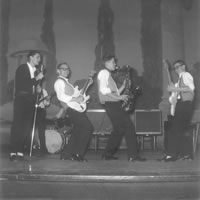
The band eventually cut the tunes in Doc Jorne’s basement studio in 1961. The resulting single was released on Jorne’s own Musitone label. “Wish For An Angel”, featuring Pete Mervenne’s impressive vocal, became a big hit on several West Michigan radio station charts including those of WGRD and WMAX. The 45 rpm even outsold Del Shannon’s big hit “Runaway” in the Grand Rapids market.
Doc Jorne had a connection with Globe Records, an affiliate of RCA. The company wanted to sign the Kingtones and distribute the record nationally. Since the boys were still in high school and underage, the contract and promotional tour required parental permission. The band could not get all of the parents to sign, however, and the deal collapsed. “Wish For An Angel” remained just a regional hit which was a big disappointment for the Kingtones. Doc Jorne left to take his Orgarama show back on the road after the distribution agreement with Globe fell through, but he had been a helpful mentor to the band and remained a good friend.
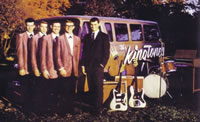 Kingtones and their tour van
Kingtones and their tour van
Phil Roberts was a big fan of Johnny and The Hurricanes and was impressed by the fact that they had their own van with the band’s name on the side. The Kingtones decided to go in together to buy a vehicle to transport them and their equipment to gigs. They purchased a Ford Econoline from Phil’s father who owned a car lot. They customized the van’s seating so that they could get all of the equipment and band members in the vehicle. They also hired soon-to-be-famous artist Paul Collins, who had done some work for Phil’s father, to paint the band name on the van.
The band released its second single, “A Love I Had” backed by “To Have A Little Girl” on their Kitoco (short for Kingtones Company) label. It was recorded in downtown Grand Rapids in a studio located in the McKay Tower. As on the first Kingtones’ single, Pete Mervenne was listed as vocalist. Pete was a big draw for the band and something of a Grand Rapids phenomenon. Mervenne was the star quarterback at Union High, he was voted ‘class king’, and he could sing falsetto five hours a night. Pete was also an expert at reading the dancers, picking the right songs to play, and a master at varying the beats to keep people on the dance floor.
A black vocal group called the El Duprees sang the backing vocals on “A Love I Had”. They had made a deal that if the Kingtones played for free at a sock hop in Muskegon, the El Duprees would sing on the recording for free. In a scene reminiscent of Buddy Holly and The Crickets’ debut at the Apollo Theater in Harlem, the Kingtones drove to the dance only to find that they were the only white faces in the building. They perservered in what could have been an uncomfortable situation because they were a band who could play the Top 40 hits that everyone listened to in 1962 whether they were white, black, red, brown, or yellow.
Despite having the potential for being a hit, “A Love I Had” didn’t get much airplay at WGRD because of a big dispute with Gil King that led to his departure from the band. The disagreement centered on Gil’s use of the Kingtones’ van. As band leader, Gil had made a rule that no one was to use the van for personal reasons. Gil was caught using the van on several occasions to visit his girlfriend. After the rest of the band called him on it, the resulting blow-up ended with Gil spitefully trying to keep all of their instruments and quitting the band he started.
Gil King had served as both the record plugger and promo man for the Kingtones. After he left the band, he got a measure of revenge when he phoned WGRD and told them the Kingtones no longer existed. As a result of his call, the station stopped playing the record and “A Love I Had” quickly lost its momentum.
After King quit the Kingtones, he played with several Grand Rapids bands including the Footsteps, the Eschelons, and the Rhythmtones. Gil was replaced on bass by original member Bob Major, who had been heartbroken earlier in the year when he had been let go by the Kingtones in a dispute over his saxophone playing.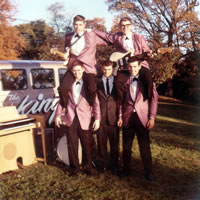
Traveling home from gigs late at night could be dangerous and the Kingtones survived a close call in 1962. They had bought the Ford van on time. The very night that they had earned enough money to make the final payment on the vehicle, the band was involved in a serious accident. They had just dropped Phil Roberts off in East Grand Rapids and were on their way to the west side of town when they were smashed into by a stolen car that had run a red light with its headlights off.
The crash occurred in the days before seatbelt laws. The impact caused Bruce Snoap’s head to hit the windshield and driver Mike King to be thrown completely through it onto the street. Bob Major was knocked out of the side doors of the van and landed close to Mike. Everyone survived although the crash seemed to trigger the diabetic condition that would plague Pete Mervenne for the rest of his life. Mike King’s injuries caused him to be hospitalized for a time, but they did help keep him out of the war in Vietnam.
Phil Roberts started building his own studio in his basement shortly after joining the Kingtones. The band was playing regularly at the Mayfair Bar in Lansing five or six nights a week, and Phil, Bruce Snoap, and Mike King were also employed at the REO Truck Co. in Lansing during the day. Bruce and Phil were partners in the studio venture and they put all the money they made into its construction.
They named it Midwestern Sound, and it went on to become a highly respected independent studio. Along with sides by the Kingtones, Phil would record songs by Al Green, De Barge, Phlegethon, members of Jr. Walker’s All Stars, the JuJus, the People’s Choice, Frederick, and many others.
In 1963 Pete Mervenne was attending Central Michigan University in Mt. Pleasant. Pete had a campus friend who became a big fan of the Kingtones. The friend knew Stan Douglas, the owner of a very successful teen club in the northern resort town of Harbor Springs, Michigan, called Club Ponytail. He recommended the Kingtones to Douglas as a weekend replacement for Corky & The Electras, the venue’s house band. Douglas was very impressed, and he hired them to play at his club for the rest of the summer.
Club Ponytail was located near scenic Little Traverse Bay and was rumored to be Mafia-connected. During Prohibition, it had been a nightclub that had served bootleg liquor that had been delivered to the club via boat. Some thirty years later it was a very elaborate setting for a teen club with a moveable wall to expand or contract the size of the venue, and polished wood floors for dancing.
The Kingtones had backed some minor recording artists at shows in Grand Rapids, but during that memorable summer of 1963, Club Ponytail featured a summer line-up that included Bobby Vee, Del Shannon, Bobby Vinton, and the Beach Boys.
The Beach Boys were booked for one show on August 8th at Club Ponytail. During their stay, the Kingtones were slotted to play in the club’s smaller downstairs room, the Hippocrene Hide-Away. The Beach Boys had just released their new two-sided hit single, "Surfer Girl/Little Deuce Coup", and Mike Love jammed with the Kingtones when he wasn’t on stage.
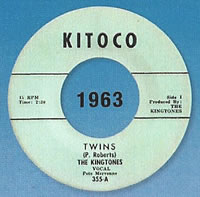
In late 1963, just prior to the start of “Beatlemania”, the Kingtones released their third single. It featured a clever Phil Roberts’ composition called “Twins” as the A-side, with “Have Faith” as its flip. The songs were recorded at Midwestern Sound with a Viking 86 tape recorder and a couple of stolen microphones from WMAX. The catchy “heys” in the background of “Twins” were provided by Phil's younger brother Dave and his friends who were having a poker game upstairs. Phil paid them $1 each to provide the memorable backing vocals. The first version of the single was released on the Kingtones’ Kitoco label in Grand Rapids and reached # 7 on the local charts.
Cadet Distributing wanted to put “Twins” out nationally but they didn’t like the unusual slow section in the middle of the song. The company felt that it would stop the people who were dancing, and wanted the band to rerecord the song with the slow section at the beginning.
The band recorded the second version of “Twins” at the Great Lakes Recording Studio when it was still located on Leonard Street in Grand Rapids. The band provided the “heys” on the new version, but they felt that the remake was hurried and that it wasn’t as good as the original. Despite their reservations, Cadet released the second version of “Twins” on their Derry label, but it failed to click with the record-buying public in the wake of the Beatles’ chart dominance in early 1964.
Looking back, the Kingtones might have made a mistake by deciding to go to Florida in the spring of 1964 rather than spending time promoting their new release. But they had a wonderful time in Fort Lauderdale, and the band got a gig playing six days a week at Porky's, one of the largest clubs in the area.
The band had become involved with Cadet Distributing through Lee Lyons, a deejay at WMAX. The Kingtones released a second potential hit single on the company’s Drummond label in 1965 with “The Girl I Love”. The Michigan Review reported it as one of the biggest-selling records in important markets such as Grand Rapids, Lansing, Flint, Detroit, and in neighboring Toledo, Ohio. Cadet promoted the single, but the recording was another victim of the British Invasion and did not get enough national radio play to move beyond its regional hit status.
After the band’s first two singles failed to break nationally Cadet lost faith in the Kingtones as a recording act and cancelled their next single, “Build A Mountain/I Am The One Who Stands Alone”. From this point on the Kingtones would record infrequently. Most of the band members were married, and they were doing very well playing in a variety of bars and nightclubs in Michigan including the Coral Gables in Lansing, The Old Crow Bar in Saugatuck, as well as local venues such as the Westgate Bowl in the Alpine Saloon and the Shamrock Lounge.
Phil’s younger brother, Dave Roberts, joined the band on bass in 1967 after Bob Major was drafted. Bob then joined the Grand Rapids Police Department to avoid going to Vietnam. Dave had experience playing with the band – he had previously filled in for Mike King on drums.
Despite an ongoing sibling rivalry with Phil that would sometimes erupt into arguments on stage, Dave turned out to be a good choice. He understood the bass lines that Phil wanted, and he and Phil sounded like the Everly Brothers when they sang together. Dave’s boyish good looks attracted female fans, and he also had a knack for picking out songs for the band that were popular with a younger audience.
Mike King left the band in 1968 to get married. Mike moved to the Detroit area, got a job, and quit playing the drums except for a few reunion shows with the Kingtones over the years. Don Henke replaced King on drums. He was a fine singer and had put out a single on the Fenton label, “Put A Tiger In My Tank/You Are The One”, with his former group, Don Henke and The Echo Men.
1968 officially marked the end of the first phase of the Kingtones’ career when the band and its talented and troubled lead singer Pete Mervenne parted ways. Pete had been having problems at gigs because of his heavy drinking. There were instances when Bob Major literally had to help hold him up on the stage, and a number of more serious incidents when Pete had drunkenly picked fights with patrons in the bars and clubs where the band was playing. This had been going on for several years, but the breaking point came after Mervenne left the band hanging by skipping out on a gig that he had earlier insisted they play.
After Pete was let go from the Kingtones, he accepted a promotion at the Detroit Free Press, moved to Flint, and got married. Mervenne took up the drums and played and sang in a country and western band there. Pete continued to suffer from diabetes that was complicated by his heavy drinking. His doctor told him that he had to stop if he hoped to live a long life but, unfortunately, Mervenne did not follow his doctor’s advice.
Shortly before his death, Pete and Bob Major played in a band called Flashback. Bob stated that Pete was taking two or three shots a day for his diabetes but, because of his drinking, was not doing a good job of keeping track of which ones he had taken. It had been Pete’s dream since his junior high days to do a marathon (ride bike, run, and swim) to the West Coast. Now in his mid-40’s, he tried to complete a modified version of it by attempting to hitch hike to California. He got as far as Las Vegas in late 1989 but died suddenly after he went into a diabetic coma and suffered a massive heart attack. Four months after his death, the Kingtones held a benefit in Grand Rapids for Pete Mervenne’s children.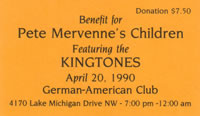
Dave Roberts, Don Henke, and Phil Roberts handled the vocals after Pete left the band, and Bruce Snoap took over the job of preparing the sets. The Kingtones had become primarily a bar band by 1969. It had been nearly four years since they last recorded, and they decided to finally put out another single. The A-side was a new arrangement of Buddy Holly’s final hit, “It Doesn’t Matter Anymore”, with Dave Roberts singing lead. “How Can A Man” was selected to be the flipside. The single was released on Eucalyptus, a label that Phil Roberts had created.
“It Doesn’t Matter Anymore” was a song they played in the clubs and was a very popular part of their set. They recorded their version at Midwestern Sound and released it six years before Linda Ronstadt would have a charting hit with her cover of the Holly hit.
“It Doesn’t Matter Anymore” was very popular with West Michigan deejays. Aris Hampers was the program director at WLAV. Hampers loved the Kingtones’ version of the song, and he helped sell it to Atlantic Records, who gave the band $1,000 down for the single.
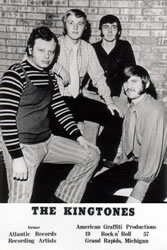
Atlantic signed the Kingtones to a three-year contract in 1970. They re-released “It Doesn’t Matter Anymore” with a new flipside, “Ten Guitars”, which featured Don Henke on lead vocal. The record was put out on their Cotillion subsidiary, but they tabled the single after sending it out to a number of radio stations and getting very little response. The Kingtones became apathetic about their recording career after the failure of “It Doesn’t Matter Anymore”. It would be their only release on Atlantic.
When Don Henke, who served as the Kingtones’ booking agent, left the band, there was no one to do the job. It was also difficult to find a drummer that fit the Kingtones’ style and played the way that Phil Roberts wanted. Denny Newville, Louie Pane, and Dave Yeakey drummed with the band for varying periods of time before "Crazy George" Campbell came on the scene.
George Campbell was a conga player who had grown up in California before moving to Michigan. He had never played drums in his life before he bonded with the Kingtones. Despite the fact that Campbell was unskilled, Phil heard something that he liked, and George eventually learned to become the drummer that Phil wanted and a master at keeping time.
“Big Jim” Lewis joined the Kingtones six months after George. Although he had never been in a band, Lewis came from a musical family and had a singing style similar to that of Elvis Presley. He first performed with the Kingtones in a bar singing “Jailhouse Rock”. The band was playing Dick’s Lakeside Inn, and the next time Jim went back, a local gang, known as the River Rats, was there and one of the members punched Phil Roberts. Lewis jumped into the fracas and rescued Roberts from the gang.
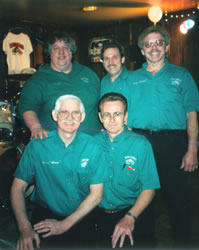
As a result, Jim became fast friends with Phil and the other members of the Kingtones, and he was invited to sing with the band any time he wanted. Lewis was also hired to book the band and was paid with a percentage of each gig. Even though he eventually slid into the lead vocal spot in the Kingtones, he continued to be paid as the booking agent for the next twenty years. The fact that he often drove the band and their equipment to gigs in his station wagon also contibuted to Jim finally becoming a full-time paid member of the band in the early 90’s.
The Kingtones last studio recording was cut in 1976. Dave Roberts paid for the “Spics And Specs” session, and therefore it was his decision to bill the band as Dave Roberts and The Kingtones on the Eucalyptus label. Dave also wrote the flipside, “You Don’t Realize”, and suggested the humorous intro on which Bruce does his best imitation of Phil. “Spics And Specs” was an Australian hit for the Bee Gees in the 1960’s, but it was difficult to get airplay for a release on a small independent label and the final Kingtones’ single sunk without a trace.
Dave Roberts left the band in 1981 – he had a car dealership and could no longer devote the time to the band that was necessary. The band continued on with a revolving set of bass players that included Bobby Stiles, Al Vendetti, Jay Fortier, Bill Van Ess, and Kevin Bouwkamp.
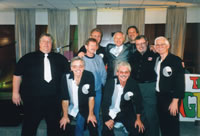 Kingtones 2002 reunion
Kingtones 2002 reunion
In 2002, the Kingtones were contacted by WGVU-TV about an idea to make a documentary on the band to be shown as a fundraiser for the PBS station. A dance party featuring the Kingtones was filmed as well as interviews with past and current members. The station also incorporated some vintage 8mm film footage of the band into an informative and entertaining program called The Kingtones: A Retro-Spective. The award-winning documentary was first shown during WGVU-TV’s March 2003 pledge drive and was a rousing success.
The Kingtones brought their fifty-year career to a close with two shows; a 50th Anniversary Dance Party at the Lincoln Country Club on November 10, 2007, and the band’s very last performance at the Creston Post V.F.W. in Grand Rapids on New Year’s Eve, December 31, 2007.
Five decades is a long time for a band to stay together. Several band mates have passed away on the long journey including Pete Mervenne, Gil King, Dave Roberts, Bobby Stiles, and Don Henke. The music and the joy of performing has kept the Kingtones going for those many years but there had to be something more.
When I interviewed Jim Lewis in 2010, he touched on what that something might be when he spoke of how much he appreciated the friendship that grew among the band members over the years. “We’ve lived so much life, we’ve lost siblings together, and we’ve watched our kids get married”, he said. “I’ve watched Bruce’s kids grow up, and I’ve learned life lessons and how to be a man through Bruce. Phil has helped me through some terrible times, and George has been my friend for many years, and we even lived together for a little while. And later on, through the band, I met Mike and Bob and I love those guys too.” Listening to Jim, it’s clear that the Kingtones are truly a brotherhood forged in Rock and Roll; and maybe that’s what it takes for a band to stay together for fifty years.
The Kingtones received the most votes of any artist in the 2010 balloting for induction into Michigan Rock and Roll Legends Hall of Fame.
Dr. J. Recommends: “Memories: The Very Best Of The Kingtones” 2007 Kingtones CD.
 This great 15 track CD has all of the Kingtones’ studio recordings from 1961 through 1976.
This great 15 track CD has all of the Kingtones’ studio recordings from 1961 through 1976.

